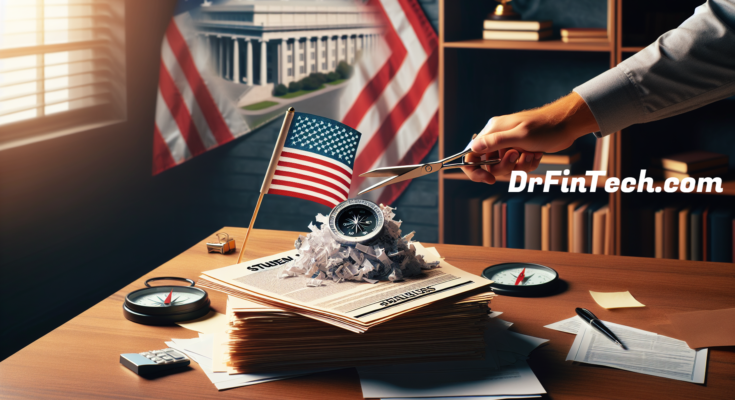Introduction
Biden student loan forgiveness is a groundbreaking solution to the US student loan dilemma. This effort intends to grant tens of millions of Americans considerable debt relief, which might change their educational debt struggles. This article will discuss the Biden-Harris Administration’s student loan forgiveness policies, their effects on borrowers, their critiques and problems, and their future effects on individuals and the economy.
President Biden’s Recent Student Debt Relief Plans
The Biden Student Loan Forgiveness Act has released sweeping student loan relief measures for millions of Americans. Policy changes addressing various facets of the student loan problem are crucial. Here are President Biden’s current student debt reduction programmes’ main components:
1. Cancellation of Accrued Interest
The Biden Student Loan Forgiveness suggests cancelling up to $20,000 for debtors whose loan balance has risen owing to unpaid interest. Even if they haven’t applied, qualifying debtors under SAVE and Public Service Loan Forgiveness will have their debt cancelled automatically.
2. Broad-based Eligibility and Implementation
Borrowers who started payments 20 years or more ago will have their loans erased.
Institution-Based Cancellation: Institutions that lost federal student financing due to wrongdoing will also cancel loans.
Hardship Considerations: A new scheme will help borrowers with challenges repay their debts.
3. Financial and Administrative Details
Funding Allocation: 277,000 debtors will get $7.4 billion in assistance from various schemes. The SAVE Plan gives almost 206,800 debtors $3.6 billion. $3.5 billion in IDR payment count modifications will help 65,800 borrowers.
PSLF enhancements benefit 4,600 borrowers and $300 million.
Income-Driven Repayment Adjustments: Plans reduce undergraduate loan payments to 5% of discretionary income. The Biden-Harris Administration’s strategic measures aim to decrease financial hardship on people and fix structural faults in educational and financial institutions that have disproportionately harmed borrowers, particularly underprivileged populations.
Key Features of the Debt Relief Proposals
The Biden student loan forgiveness plan includes many essential components to help millions of borrowers. Major components are listed below:
1. Cancellation of Accrued Interest and Debt Relief
Accrued Interest: The idea would remove up to $20,000 in accumulated interest for 25 million borrowers.
Debt Elimination: Borrowers who have repaid undergraduate and graduate loans for 20 or 25 years will have their debt eliminated.
2. SAVE Plan: A Core Component of the Forgiveness Strategy
Financial Hardship Protection: Prevents debtors from overpaying. Graduates’ monthly payments are set at 5% of discretionary income, easing financial hardship.
Equity Considerations: The SAVE plan benefits low-income borrowers and resolves student debt inequities by race. It covers unpaid monthly interest to prevent loan balances from rising, which disproportionately impacts Black borrowers.
Long-term Benefits: Forgives loans under $12,000 after 10 years. Larger debts are forgiven after 20 or 25 years, depending on kind.
3. Broad Eligibility and Automatic Enrollment
Income Considerations: Relief for low- and middle-income individuals under $125,000. This includes cancelling all accumulated interest for eligible borrowers in this income category.
Automatic Features: The plan automatically cancels long-term loans and wipes away accrued interest, eliminating the need for borrowers to complete cumbersome application processes.
Impact on Borrowers
Biden student loan forgiveness will assist borrowers across demographics with immediate financial relief and long-term economic rewards. The main effects on borrowers are:
1. Immediate Financial Relief
Many Will Have Their Student Debt Eliminated: An estimated 20 million debtors will have a fresh financial start.
Refund Opportunities: Borrowers who have paid after the March 2020 payment stop may be entitled for refunds, boosting their disposable income.As debts are decreased or erased, debtors’ credit ratings may improve, allowing them to borrow more cheaply.
2. Long-term economic and social gains
Increased Educational Pursuits: Reducing debt may encourage more people to seek higher education, which the Council of Economic Advisers estimates may enhance GDP by 1% by 2055 if participation rises by 5%.
Enhanced Life Outcomes: Debt alleviation improves health, reduces stress, and increases the possibility of economically beneficial actions like entrepreneurship and property purchases.
Racial and Socioeconomic Equity:Low-income and minority borrowers benefit most from SAVE. The Urban Institute anticipates that many black and Hispanic students’ credentials would be forgiven, addressing previous academic and income disparities.
3. Public Service and Hardship Case Impact
Public Service Loan Forgiveness (PSLF): 900,000 Americans who have committed their lives to public service will benefit from targeted debt forgiveness, improving job satisfaction and financial stability in key industries.
Support for Borrowers in Hardship: The scheme supports vulnerable borrowers with high loan default risk or high non-discretionary expenditures.
Critics and Challenges
Despite its ambitious goals, the Biden student loan forgiveness plan has faced several critics and challenges:
1. Economic and Legal Issues
Inflation Risks: Critics worry the strategy would raise inflation. Forgiving debt increases the money supply but not goods and services, which might raise prices.
Legal Issues: The executive branch’s legal authority to implement this strategy is disputed. Opponents say Congress should authorise broad loan cancellations.
2. Scope and Equity Issues
Regressiveness: Critics say the proposal favours higher-income people with more graduate school debt over low-income workers.
Exclusion of Private Loan Borrowers: Private student loan borrowers and those whose debt exceeds forgiveness limitations are excluded, leaving a large demographic without assistance.
3. Implementation and Future Uncertainties
Congressional Bypass and Executive Overreach: Critics believe the idea overreaches executive power by circumventing Congress. Legal challenges have arisen from this worry, which might delay or derail the scheme.
Potential Delays: The Department of Education is reviewing over 26,000 public comments and creating rules for OIRA and OMB review. Legal disputes may postpone cancellations using this new jurisdiction until mid-2024.
Future Implications
The Biden student loan forgiveness plan offers various policy changes that might affect US higher education and economic consumption. Important future ramifications of this initiative:
1. Automatic Debt Cancellation:
Many debtors eligible for relief have faced bureaucratic difficulties, including complicated paperwork and misguided counsel. The new strategy immediately cancels debt for qualified SAVE, closed school discharge, PSLF, and other programmes to ease this procedure.
2. Economic Impact
Increased Consumption: Analysts expect the forgiveness will raise consumption by many billions of dollars annually over the following decade. This rise is predicted since borrowers have greater disposable income.
Federal Cost: The 10-year plan might cost $1 trillion. This large cash commitment shows the initiative’s scope and possible government resource pressure.
3. Educational and Institutional Effects
Fees for enrollment and tuition
Increased Enrollment: The idea may increase college enrollment by minimising financial risks. This may result in a more educated workforce.
Tuition Adjustments: To counteract revenue lost from forgiven debts, colleges may raise tuition. This may negate some of the plan’s benefits.
4. Precedential Impact
The adoption of a broad forgiveness programme might influence future governments. This decision might allow future administrations to adopt similar or increased student loan policies, changing American higher education spending.
Conclusion
We have examined the Biden student loan forgiveness initiative’s difficulties and transformational possibilities. The project addresses the US student loan issue by providing immediate assistance to millions of debtors and pursuing long-term fundamental improvements in education and economics. While facing legal challenges and criticism, its holistic approach to financial burdens, higher education accessibility, and fairness concerns promises to transform borrowers’ lives and the nation’s economy.
FAQs
1. The US student debt crisis: what’s happening?
In the second quarter of fiscal year 2022, 45.3 million borrowers had federal student debt, down from 45.4 million. As of Q2 2023, 0.63% of student loans are 90 days or more late.
2. Is student loan forgiveness happening under this administration?
The Biden-Harris Administration has forgiven $146 billion in student loans for 4 million Americans. Over two dozen executive measures, including public service loan forgiveness and income-driven repayment plan changes, have ensured debtors obtain legal relief.
3. Has the Biden administration eliminated student debt for 74,000 borrowers?
The Biden administration just cancelled debt for 74,000 more student loan debtors. This means nearly 3.7 million Americans have had their school debt forgiven under various schemes since the administration’s start.
4. How do I determine student loan forgiveness?
After 240 or 300 months of acceptable payments under Income-Driven Repayment (IDR) arrangements, borrowers will have their loans erased. The Education Department (ED) will discharge loans when debtors make the appropriate payments for forgiveness.



